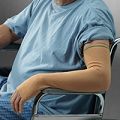
Skin tears are traumatic injuries to the skin, our largest organ. As we age, our skin thins and becomes more fragile. Skin tears are categorized in two ways; partial or full separation of the outer skin. Some skin tears are inescapable, but many times, with the proper equipment - like a compression sleeve or a skin sleeve - these skin tears can be prevented. Skin sleeves, protectors, pillows and cushions are economical remedies that help prevent and minimize skin tears.
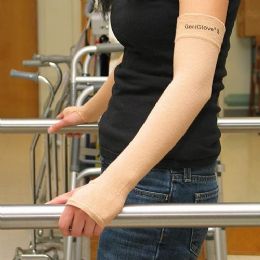
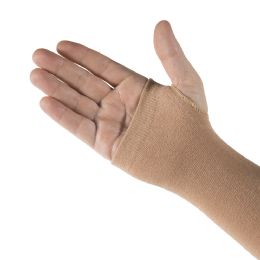
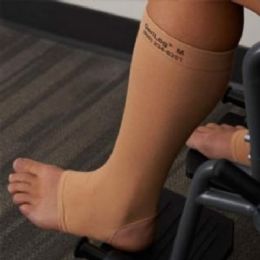
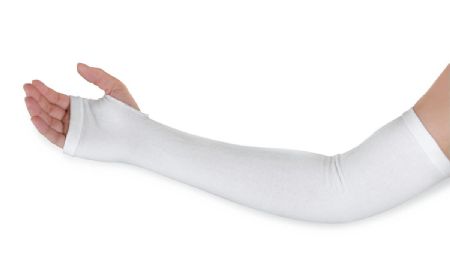
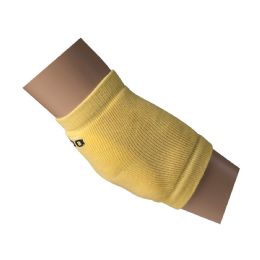
What Causes Skin Tears?
The most innocent impact between a hand or an elbow to a door or wall can cause a substantial skin tear. A simple bump can result in tissue damage. A moderate slip and fall can result in a severe skin tear.
Friction, like briskly rolling out of bed, or quickly transferring a patient from the bed to a wheelchair, or sliding the skin over any surface, can cause the epidermis to partially separate from the dermis.
This is called a partial thickness separation.
Blunt force, like bumping into a night side table, door or wall can cause both the epidermis and the dermis to separate from the underlying tissue, and this is known as a full-thickness wound.
It seems unreasonable, but as we age, our skin is naturally thinning, developing wrinkles and folds and putting us at risk for tears. It is also drying out – dry skin tears much more easily than plump, well-nourished skin.
Certain medications can cause the skin to thin and increase the risk for tearing, like cancer drugs, asthma drugs, and blood thinners like coumadin and warfarin. Even aspirin, Advil and Motrin can thin the skin and lead to bruising. Bruised skin can lead to skin tears.
Where Do Most Skin Tears Occur?
Most skin tears occur on the limbs; hands, forearms and elbows, as well at the knees, feet and ankles.
We offer a variety of inexpensive, preventative measures - like latex-free protective sleeves to prevent tearing and shearing of skin.
● Our sleeves provide either compressive or non-compressive barriers to protect fragile, thin skin and tissue.
● Our skin care protectors and skin sleeves are manufactured with the highest quality lycra-cotton blended materials to provide a snug and comfortable fit.
● Elbow cradles and heel protectors are very popular and effective guards against skin tears. The open mesh sleeve provides a cool, seamless, padded inner cushion to reduce shearing and constriction.
● Gel heel pillows are perfect for the prevention of skin breakdown, friction burns or foot drop. These skin tear-preventative devices feature a soft, non-shear polyester fabric shell with a hollow core microfiber filling, and a removable gel pad that fits under the calf to aid hot and cold therapies. The open heel cutout ensures heel isolation while reducing friction and heat buildup and promoting air circulation.
● Wheelchair foot cushion protectors and wheelchair leg pads provide exceptional protection for patients who require lower extremity or cushioned leg support to avoid skin tears to their lower body.
Are Skin Tears Dangerous?
Skin tears can be significant and complex wounds. Infections are a common result of a relatively minor skin tear, particularly for seniors and people with deficient immune systems – or anyone with dry fragile skin.
Unfortunately, routine actions result in tears, so not all skin tears can be avoided. Activities like a caregiver assisted transfer from a wheelchair to the shower and other normal routine actions can create potential skin tear threats to seniors and the elderly.
Skin tears can be very painful. The tearing of the skin, whether a partial or full separation of the outer skin, will cause nerve endings to painfully flare. Skin tears can often result in open wounds that require stitches and additional procedures.
Hazardous skin tears are not just for the elderly; babies, children, people with immature skin as well as people with other risk factors should be protected from skin tears.
Skin tears are particularly risky for people who are critically ill or suffering from heart disease or renal failure. People who have recently had surgical procedures or those taking medically prescribed steroids for inflammation after surgery should also be protected from skin tears.
Prevent Tears, Prevent Trauma
Prevention is the most important factor when it comes to skin tears. Wearing a skin sleeve, elbow cradle, heel protector and other preventative measures will greatly reduce the occurrence of skin tears.
There are several ways that you can protect yourself from painful skin tears.
● Be aware; caregivers should assess patients for tears daily, especially elbows, forearms, hands, legs and heels for signs of compromised or fragile skin.
● Avoid any type of friction to limbs.
● Create a safer environment specifically for people with sensory or visual impairment who are at higher risk for skin tears.
● Provide additional lighting for gray or dark areas.
● Move bedside tables and other small furnishings that are easily bumped with shins or the lower leg.
● Add additional padding, bumpers or upholstery to sharp corners, bed rails and wheelchairs.
● Dry skin tears very easily, use skin cream and a good skin care program to maintain the integrity of your skin.
Rehabmart is pleased to offer a wide selection of skin tear prevention products from superior quality vendors like Posey, Medline, Kinship and Bird and Cronin.
Hulet Smith, OTR/L
Rehabmart Co-Founder & CEO
js